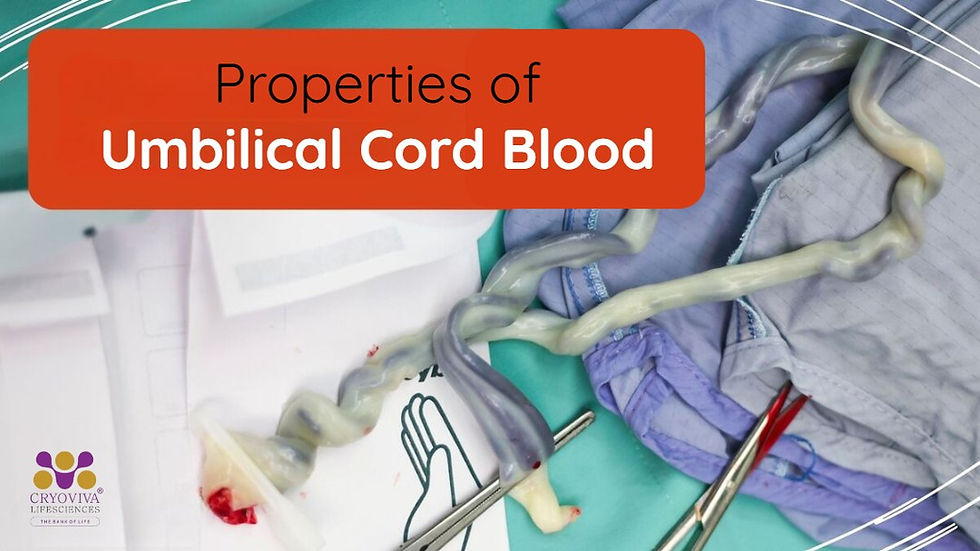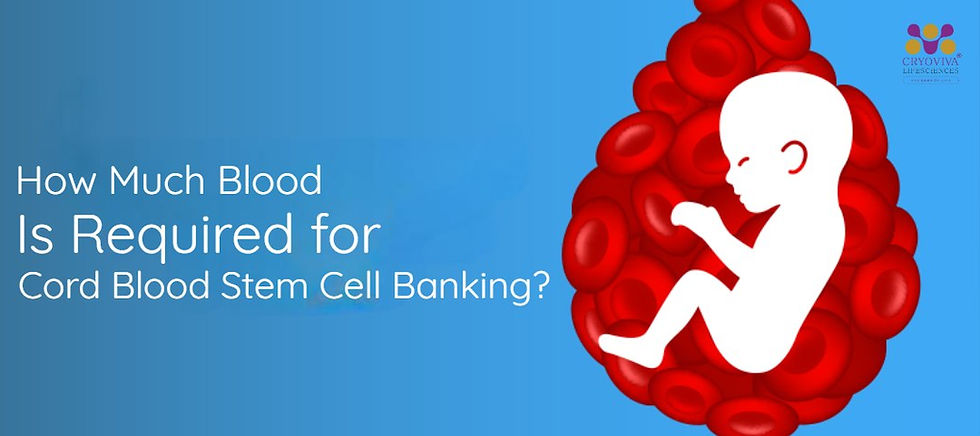Properties of Umbilical Cord Blood
- cryovivals
- Sep 18
- 4 min read

Umbilical cord blood is one of those biological materials that people barely used to talk about. It was there at birth, got discarded in minutes, and never entered the conversation again. That was until researchers started paying close attention to what is actually inside this blood. Once that happened, things changed. Because what sits inside umbilical cord blood is not ordinary. It carries a set of rare properties, especially in the form of stem cells that are younger, more adaptable, and more immunologically quiet compared to other sources. This blood is collected from the cord and placenta immediately after delivery. It is rich, it is clean, and it is still untouched by environmental and immunological wear that comes with age.
There is value in understanding why this blood matters at a cellular level. Why its structure, its stem cell content, and its biological behavior make it a serious clinical resource. Every sample holds potential. And that potential is measurable.
Let us learn more about the vital properties of umbilical cord:
Stem Cell Properties in Cord Blood
Cord blood is loaded with hematopoietic stem cells. These are the stem cells that give rise to the entire blood system: red blood cells, white blood cells, platelets, everything. What separates these cells from adult ones is their age and their flexibility. They divide faster, plus they adapt better. Also, they tolerate wider donor-recipient mismatches, especially in transplants. That is a major reason why cord blood is being used in stem cell transplants across both paediatric and adult cases.
There is also a difference in how cord blood stem cells behave in culture. They show higher colony-forming efficiency. They express surface markers in patterns that support regenerative potential. They carry longer telomeres, which translates to more replication cycles before senescence. In simpler terms, the stem cells inside cord blood are fresher, they last longer, and they do more. That is the core biological advantage.
Cord Blood Benefits in Clinical Use
The clinical value starts with haematology. Conditions like thalassemia, leukaemia, severe aplastic anaemia, and immune deficiencies are being treated using cord blood stem cells. That part is well established. The reason it works is because the cells can repopulate a patient’s blood and immune system from scratch.
Matching flexibility is another benefit. Because cord blood stem cells are immunologically naïve, they do not trigger strong rejection reactions. This has made cord blood especially valuable in patients who struggle to find matched bone marrow donors.
Trials are also exploring the use of cord blood in neurological conditions like cerebral palsy and autism. The idea is to use the immune-modulating and repair-supporting effects of the cells to alter inflammatory environments in the brain. These trials are still growing. But they are being designed with strict biological logic. They are not being driven by theory alone.
Other Umbilical Cord Uses Beyond Blood
The cord tissue also carries mesenchymal stem cells. These are different from the hematopoietic ones. They help with tissue repair and inflammation control. These are the cells being explored in arthritis, wound healing, and even cardiac tissue repair. Wharton’s jelly, the substance around the blood vessels inside the cord, is where most of these cells live. This is why many families now choose to store both cord blood and cord tissue.
Cord Blood Properties That Matter for Banking
The properties of cord blood that matter for long-term storage include stem cell count, viability, sterility, and handling quality. Every step, from collection at birth to cryopreservation in storage tanks, has a direct impact on whether the sample will perform when used. This is where a proper baby cord blood banking service becomes critical. Storage alone is not the value. The value sits in how well the cells survive the freeze and how quickly they can be used if needed.
Biological Reasoning Behind Baby Cord Blood Banking
When a family chooses to preserve cord blood, they are preserving a live population of stem cells that match the child perfectly and can be used for matched siblings. The idea is not to freeze and forget. The idea is to give that child, and that family, access to cellular material that has already proven itself in dozens of medical conditions. There is no guesswork or vague promise. What exists is a growing body of clinical practice that uses cord blood in transplant medicine, immune repair, and experimental regenerative therapies with logic, structure, and data.
In Closing
Umbilical cord blood holds a specific set of stem cells that behave differently than cells from adult bone marrow or peripheral blood. These differences come from age, environment, and inherent biological design. They grow more, tolerate better, and repair faster. The benefits stretch from paediatric cancer to inherited metabolic disease to immune modulation trials.
For families thinking in biological terms, a trusted baby cord blood banking service is more than a backup. It is a science-based investment in future options. When that banking is handled properly, with clean collection, precise storage, and full documentation, the stored sample becomes one of the most valuable medical resources that a child will ever own.



Comments